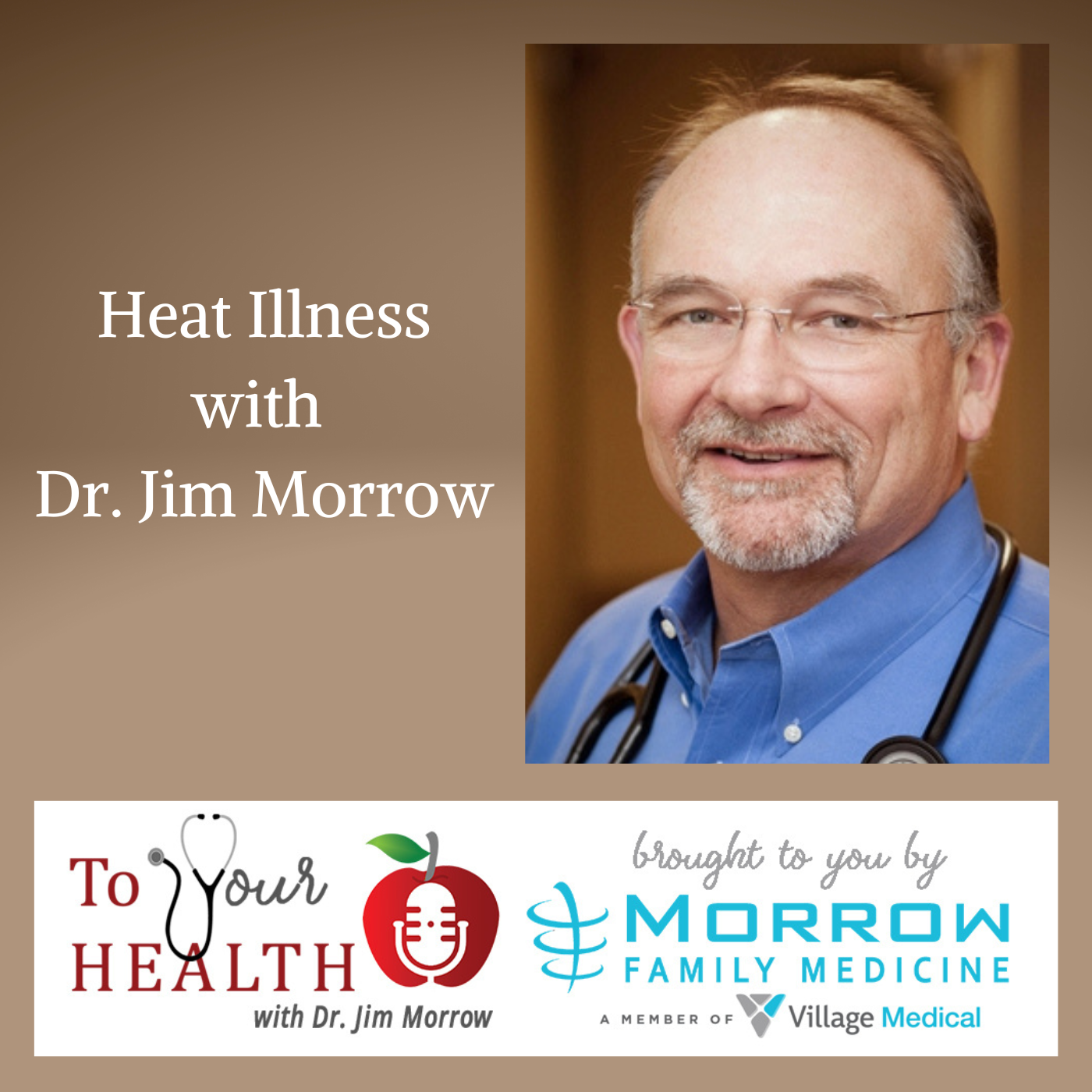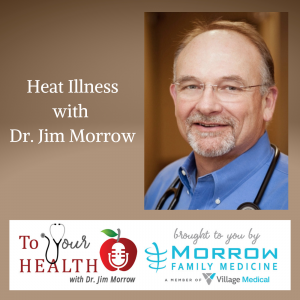
Heat Illness (Episode 78, To Your Health with Dr. Jim Morrow)
On this episode of To Your Health, Dr. Jim Morrow of Village Medical offered common sense information about heat illness. After a brief update on monkeypox, Dr. Morrow discussed how to recognize heat illness, how to prevent it, what causes it, ways to treat it, when to call 911, and much more.
To Your Health is brought to you by Village Medical (formerly Morrow Family Medicine), which brings the care back to healthcare.
About Village Medical (formerly Morrow Family Medicine)
Village Medical, formerly Morrow Family Medicine, is an award-winning, state-of-the-art family practice with offices in Cumming and Milton, Georgia. The practice combines healthcare information technology with old-fashioned care to provide the type of care that many are in search of today. Two physicians, three physician assistants and two nurse practitioners are supported by a knowledgeable and friendly staff to make your visit to Village Medical one that will remind you of the way healthcare should be. At Village Medical, we like to say we are “bringing the care back to healthcare!” The practice has been named the “Best of Forsyth” in Family Medicine in all five years of the award, is a three-time consecutive winner of the “Best of North Atlanta” by readers of Appen Media, and the 2019 winner of “Best of Life” in North Fulton County.
Village Medical offers a comprehensive suite of primary care services including preventative care, treatment for illness and injury, and management of chronic conditions such as diabetes, congestive heart failure, chronic obstructive pulmonary disease (COPD) and kidney disease. Atlanta-area patients can learn more about the practice here.
Dr. Jim Morrow, Village Medical, and Host of To Your Health with Dr. Jim Morrow
 Dr. Jim Morrow is the founder of Morrow Family Medicine. He has been a trailblazer and evangelist in healthcare information technology, was named Physician IT Leader of the Year by HIMSS, a HIMSS Davies Award Winner, the Cumming-Forsyth Chamber of Commerce Steve Bloom Award Winner as Entrepreneur of the Year and he received a Phoenix Award as Community Leader of the Year from the Metro Atlanta Chamber of Commerce. He is married to Peggie Morrow and together they founded the Forsyth BYOT Benefit, a charity in Forsyth County to support students in need of technology and devices. They have two Goldendoodles, a gaggle of grandchildren and enjoy life on and around Lake Lanier.
Dr. Jim Morrow is the founder of Morrow Family Medicine. He has been a trailblazer and evangelist in healthcare information technology, was named Physician IT Leader of the Year by HIMSS, a HIMSS Davies Award Winner, the Cumming-Forsyth Chamber of Commerce Steve Bloom Award Winner as Entrepreneur of the Year and he received a Phoenix Award as Community Leader of the Year from the Metro Atlanta Chamber of Commerce. He is married to Peggie Morrow and together they founded the Forsyth BYOT Benefit, a charity in Forsyth County to support students in need of technology and devices. They have two Goldendoodles, a gaggle of grandchildren and enjoy life on and around Lake Lanier.
The complete show archive of To Your Health with Dr. Jim Morrow addresses a wide range of health and wellness topics.
Dr. Morrow’s Show Notes
What are heat exhaustion and heatstroke?
- Heat exhaustion happens when your body gets too hot.
- If you don’t treat heat exhaustion, it can lead to heatstroke.
- This occurs when your internal temperature reaches at least 104°F.
- Heatstroke is much more serious than heat exhaustion.
- It can cause shock, organ failure, or brain damage. In extreme cases, heatstroke can kill you.
Symptoms of heat exhaustion and heatstroke
- Symptoms of heat exhaustion are:
- Muscle cramps
- Heavy sweating
- Pale or cold skin
- Weakness and/or confusion
- Dizziness
- Headache
- Nausea or vomiting
- Fast heartbeat
- Dark-colored urine, which indicates dehydration
- In addition to these symptoms, warning signs of heatstroke also include:
- Fever of 104°F or higher
- Flushed or red skin
- Lack of sweating
- Trouble breathing
- Fainting
- Seizures
What causes heat exhaustion and heatstroke?
- Heat-related illnesses occur when your body can’t keep itself cool.
- As the temperature rises, your body produces sweat to stay cool.
- On hot, humid days, the increased moisture in the air slows down this process.
- When your body can’t cool, your temperature rises and you can become ill.
- As the temperature rises, your body produces sweat to stay cool.
- Hot weather and exercise are the main causes of heat exhaustion and heatstroke.
- In hot settings, you need to be mindful of the temperature outside.
- The heat index is not the same as the temperature.
- It measures the air temperature plus the effects of humidity.
- A heat index of 90°F or higher calls for extreme caution.
- Prolonged exposure to high temperatures increases your risk of heat-related illnesses.
How are heat exhaustion and heatstroke diagnosed?
- If a person is displaying known heat illness symptoms,
- take their temperature.
- A reading of 104°F or more means they probably have heatstroke.
- You should call 911 and get medical care right away.
Can heat exhaustion and heatstroke be prevented or avoided?
- There are many things you can do to prevent heat-related illnesses.
- Babies, children, and elderly people are more sensitive to heat and require extra attention.
- You also are at greater risk if you are ill or obese, or have heart disease.
- People who work outside or in a hot setting also are at risk of heat exhaustion and heatstroke.
- Don’t go outside when the temperature and heat index are high.
- If possible, stay indoors in air-conditioned areas.
- If you must go outside, take the following precautions.
- Wear lightweight, light-colored, loose-fitting clothing.
- Protect yourself from the sun by wearing a hat or using an umbrella.
- Use sunscreen with a sun protection factor (SPF) of 15 or higher.
- Drink plenty of water throughout the day.
- Dehydration and lack of salt contribute to heat-related illnesses.
- Some sports drinks can help replenish the salt in your body lost through sweating.
- Drink water or other fluids every 15 to 20 minutes, even if you don’t feel thirsty.
- If your urine is clear, you are probably drinking enough fluids.
- Dark-colored urine is a sign that you’re dehydrated.
- Avoid or limit drinks that contain caffeine (such as tea, coffee, and soda) or alcohol.
- Schedule outdoor activities for cooler times of the day — before 10 a.m. and after 6 p.m.
- Take frequent breaks from the heat and outdoor activities.
- Do not stay in or leave a child in your car when it is hot outside.
- Even if you open the windows, the intense heat can be extremely dangerous.
- Certain medicines can put you in danger of heatstroke.
- They affect the way your body reacts to heat.
- Talk to your doctor if you take any of these or have an ongoing health problem.
- They can help you manage the heat with your condition.
- These medicines include:
- Antibiotics
- Allergy medicines (antihistamines)
- Some medicines used to manage blood pressure, cholesterol, and heart disease (beta-blockers and vasoconstrictors)
- Some medicines that treat mental health problems (antidepressants and antipsychotics)
- Seizure medicines (anticonvulsants)
- Water pills (diuretics)
- Laxatives
- Some diet pills
- Prescription acne medicines
- Illegal drugs, such as cocaine (amphetamines)
- They affect the way your body reacts to heat.
Heat exhaustion and heatstroke treatment
- If you or someone else has heat exhaustion, treat symptoms in the following ways.
- Get out of the heat quickly
- and into a cool place, or at least shade.
- Lie down and elevate your legs
- to get blood flowing to your heart.
- Take off any tight or extra clothing.
- Apply cool towels to your skin or take a cool bath.
- This will help regulate and lower your internal body temperature.
- Drink fluids, such as water or a sports drink.
- Do not guzzle them, but take sips.
- Do not drink fluids with caffeine or alcohol.
- Get out of the heat quickly
- Call 911 if:
- Symptoms don’t improve
- or they still have a fever of 102°F after 30 minutes of initial treatment.
- The person goes into
- shock,
- faints,
- or has seizures.
- The person is not breathing.
- You also should begin CPR right away to try and revive them.
- Symptoms don’t improve
Living with heat exhaustion and heatstroke
- After you’ve had heat exhaustion or heatstroke,
- you will be sensitive to heat.
- This can last for about a week.
- It’s important to rest and let your body recover.
- Avoid hot weather and exercise.
- Ask your doctor when it’s safe to return to your normal activities.
Complications
- Complications include secondary infections, pneumonia, sepsis, encephalitis, and loss of vision if severe eye infection.
- If infection occurs during pregnancy, still birth or birth defects may occur.
- The disease may be milder in people vaccinated against smallpox in childhood.
Causes
- Monkeypox in both humans and animals is caused by infection with the monkeypox virus – a double-stranded DNA virus.
- The virus is found mainly in tropical rainforest regions of Central and West Africa.
- The virus is split into Congo Basin and West African clades, matching the geographical areas.
- Most human cases of monkeypox are acquired from an infected animal,
- though the route of transmission remains unknown.
- The virus is thought to enter the body through broken skin, the respiratory tract, or the mucous membranes of the eyes, nose, or mouth.
- Once a human is infected, transmission to other humans is common, with family members and hospital staff at particularly high risk of infection.
- Human-to-human transmission is thought to occur primarily through close contact with an infected subject.
- There are indications that transmission occurs during sexual intercourse.
- Monkeypox symptoms tend to begin 5 to 21 days after infection.
Prevention
- Vaccination against smallpox is assumed to provide protection against human monkeypox infection
- because they are closely related viruses
- and the vaccine protects animals from experimental lethal monkeypox challenges.
- This has not been conclusively demonstrated in humans because routine smallpox vaccination was discontinued following the eradication of smallpox.
- because they are closely related viruses
Treatment
- In the European Union and the United States, tecovirimat is approved for the treatment of several poxviruses, including monkeypox.
- Best Practice recommends tecovirimat or the smallpox treatment brincidofovir as the first line antiviral treatment if required,
- alongside supportive care (including antipyretic, fluid balance and oxygenation).
- Empirical antibiotic therapy or aciclovir may be used if secondary bacterial or varicella zoster infection is suspected, respectively.
- Best Practice recommends tecovirimat or the smallpox treatment brincidofovir as the first line antiviral treatment if required,















